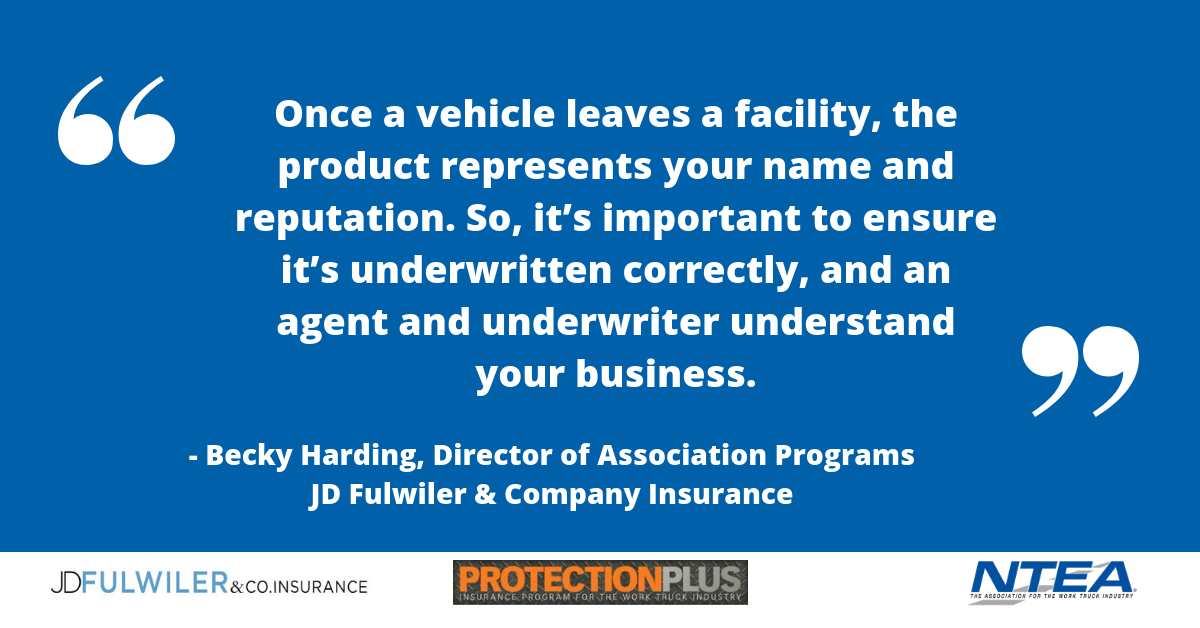
GUEST EDITORIAL
By Becky Harding,
CPCU
Director of Association
Programs
JD Fulwiler & Company
Insurance
877-924-5777
Updated October 2020.
The Product Liability portion of a General Liability insurance policy
is significant to truck equipment upfitters. Once a vehicle leaves a facility,
the product represents your name and reputation. So, it’s important to ensure
it’s underwritten correctly, and an agent and underwriter understand your
business. This will help prevent surprises during a claim or audit.
While reviewing policies for companies in the work truck industry, I
found an alarming number of misclassifications of General Liability policies —
of which Product Liability is included. Two common problems are incorrectly
rating upfitters as either auto/truck repair facilities, or vehicle
dealers.
Clarifying key
issues
The correct classification for an
upfitter is Insurance Services Office (ISO)1 General Liability (GL)
classification 51250 – Auto & Truck Body Manufacturing, as defined by
ISO:
Automobile, bus or truck body manufacturing includes
the following process to suit customer’s need. Unit can be built either as
special or stock body to fit chassis. Metal is received. Templates are laid out
to mark size and shape. Material is cut by burning or shears. Shaping is done by
heating and hammering, power brakes and rollers. Fabricating includes clamping,
dogging, heating, hammering, tacking, welding, grinding, cleaning and
painting.
An incorrect classification for upfitters is ISO GL
classification 10073 – Auto Repair or Service Shops. Abbreviated ISO definition:
This classification includes automobile repair work
that ranges from the changing of a tire to a complete engine overhaul. Skilled
mechanics are employed by these repair centers to repair ignition systems,
mufflers, brakes, automatic and manual transmissions, and other mechanical
repairs. These repair centers may operate as a specialty repair shop dealing
primarily in one type of repair, such as transmissions, radiators, mufflers,
brakes, etc., or if large enough, may offer a variety of mechanical repair
services, as well as vehicle inspections.
This classification also contemplates automobile
paint shops, body shops as well as specialty risks performing rustproofing
operations including those risks applying spray-on bedliners to pickup trucks.
Code 10073 contemplates those risks, which are
not trailer dealers that perform trailer repair work – including the
installation of trailer hitches on vehicles.
While the auto repair class may describe a few operations in an
upfitting shop, it does not incorporate the essence of work performed by an
upfitter, which is the manufacture of bodies/equipment and/or installation of
equipment to the chassis. In fact, the auto repair class doesn’t take into
account chassis work of any kind.
Another error is classifying an upfitter with a dealer’s license as a
dealer ONLY. This is a common mistake, because a typical dealer’s policy
automatically includes the incidental repair facility within the dealership
(such as oil changes, small dent repair, etc.). However, as previously stated,
upfitters are not properly classified as a repair facility. In this scenario,
the dealership and upfitting operation should be rated separately.
Your question may be, “How can this misclassification affect me?”
First, most general liability policies have a clause for “misrepresentation.”
This allows the insurer to cancel your policy mid-term in the event they were
not adequately informed of your operations, either by you or your agent. (The
only other time an insurer has the right to cancel mid-term is for non-payment
of premium.)
Second, in the event of a claim, an adjuster would likely note the
operations described on the policy and/or application for coverage differ from
your actual operations. In this situation, the claim would typically be
paid, but could result in subsequent problems. If, for example, the policy shows
you as a repair facility and you have a claim regarding a body you installed
onto a chassis, the insurer would be made aware of the discrepancy. This could
mean non-renewal, a sizeable increase in premium or even mid-term
cancellation.
As the soft insurance market of the past decade moves away, the need
for proper classification becomes more prominent. Insurers are reviewing risks
with more scrutiny, agents are required to provide a clearer picture of the
client’s operations, and pricing is increasing to reflect these
changes.
The current insurance climate encourages having a good understanding of
your policy and conducting a thorough review with an agent for accuracy. This
can help prevent a possible problem, which could not only cause unnecessary
frustration, but cost additional premium dollars.
As the preferred insurance agency of the NTEA, JD Fulwiler developed
the Protection Plus
program to provide the industry with
underwriting, risk assessment and loss prevention services. JD Fulwiler will
shop among many top insurance carriers with which it does business to find a
coverage solution that best meets your needs.
1 ISO is a provider of, among other
things, regulatory and underwriting data which is used by insurance companies
across the United States. Nearly all insurers use ISO classification data when
underwriting a risk.
